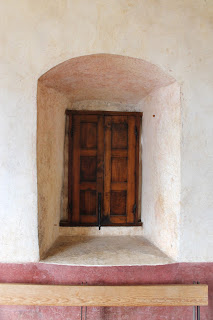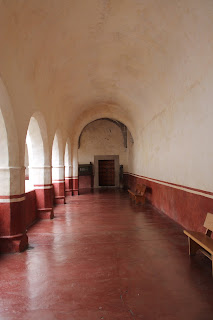On the left hand of the main entrance to the Church of the Nativity of Our Blessed Mother Tepoztlán, lies a "Capilla de Pozo" (Well or Corner Chapel), which also served as the entrance to Monastery, first for the Dominicans and then for secular priests.
Entrance chapel to the Monastery of Tepoztlan.
The walls and ceilings of the monastery are painted
with friezes with motifs of the Dominican Order.
One symbol used extensively in the friezes on the
walls is the Lily, Symbol of the Purity that
Dominicans aspire to imitate from the
Blessed Virgin Mary
Patio with central fountain and
two floor double archway.
Estela under the arch gives us an idea of the
thickness of the walls in the Monastery of Tepoztlan
Frieze with a vase of flowers with the inscription
Maria, with worshiping royalty on both sides.
These monastery passageways had
ideal acoustics. Notice the friezes
on the walls and ceilings
Other more complex and ornate iconography as
frieze or wall border
The four pillar of the life of the Dominicans are prayer, study, community and ministry.
The life of prayer for a Dominican is a combination
of activities of the body, the mind and the spirit.
The Dominicans fully exercise their bodies during prayer, genuflecting, kneeling, raising their arms and in prostration,
For Dominic de Guzman, prayer was more than a mental activity or exercise, but rather an intimate conversation with God.
The Monastery was occupied by the Dominicans approximately 200 years, from 1555 until 1773, when it was handed over to the Diocesan priests, who occupied the Monastery until 1857, when under the Laws of the Reforma, it was evacuated.
Every Dominican priest has the suffix "O.P." after his name, meaning that he belongs to the "Ordo Predicatorum" (Order of Preachers). There mission is "contemplata aliis tradere": to contemplate the word of God and to take it to others.
Dominican prayer is human, Eucharistic and
contemplative.
The third quality of prayer for the Dominicans is
that we must contemplate. According to the
Dominicans, we are all called to have a
contemplative life of prayer with God.
A second major dimension or pillar in the life of
the Dominicans is his life of Study.


When I looked out of that window, and contemplated
the beautiful landscape of the Tepoteco and the fertile
valley, I wondered if the Dominican monks centuries
ago, had a similar feeling as I had: that of
contemplating Paradise.


The latrines of the Monastery

Doorway leading to what was
possibly an orchard centuries ago.
























































No comments:
Post a Comment